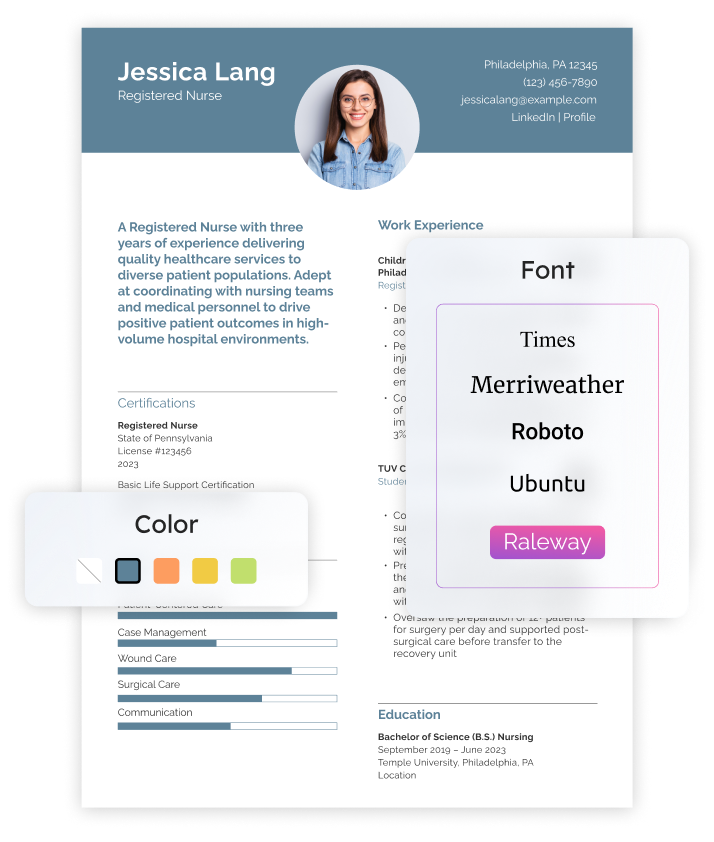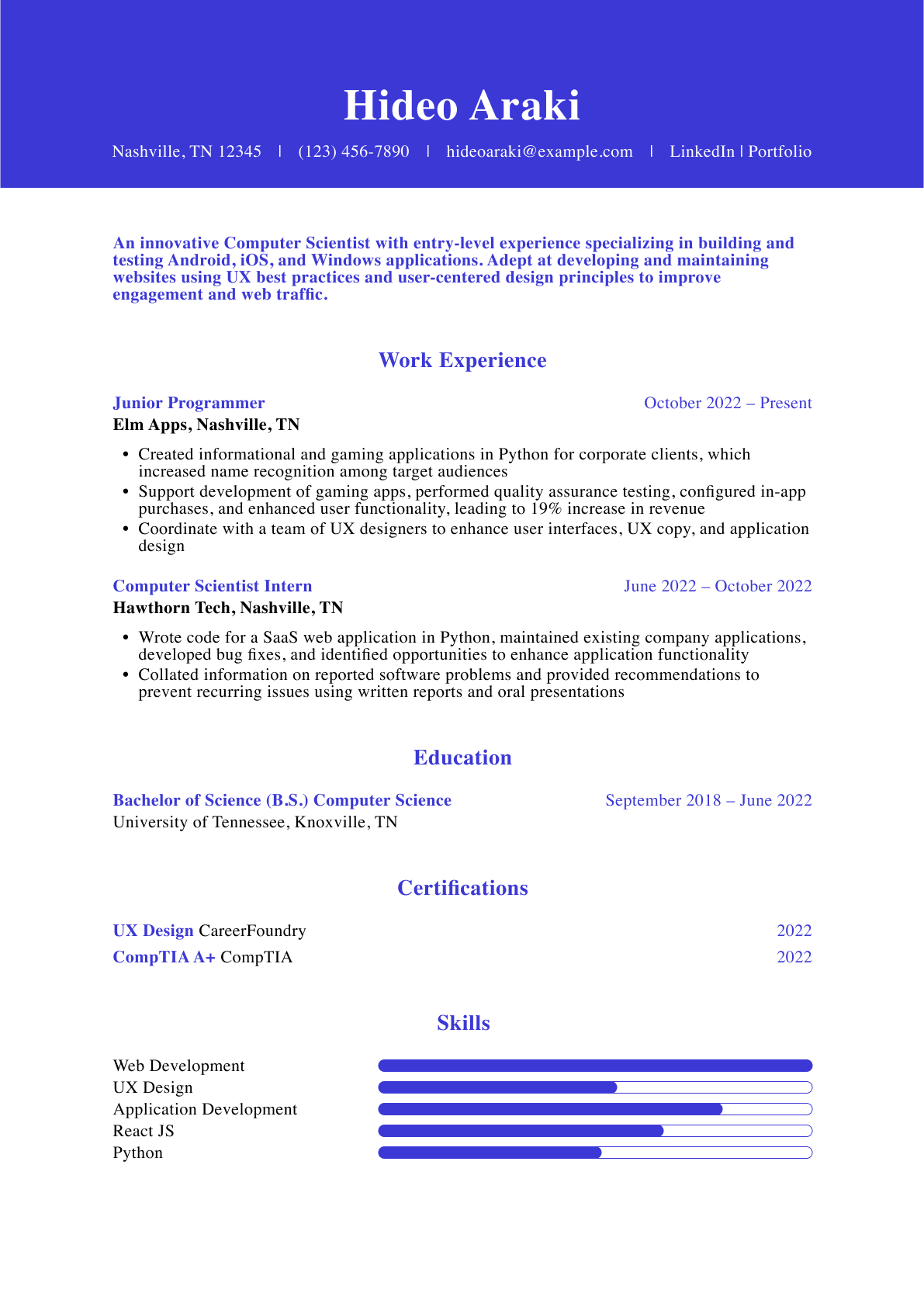Wondering how far back a resume should go? You need to balance highlighting your professional experience while still providing a concise resume that doesn’t overwhelm the hiring manager. What you should include and how long your resume should be depends on your background and the position’s requirements. In this article, we explain how far back a resume should go and provide best practices and tips for writing the work experience section of your resume.
Deciding How Far Back To Go on Your Resume
When determining how far back to go on a resume, here’s a good rule of thumb: Identify the number of years your target role calls for, as specified in most job ads, and go back at least that far. Knowing how far back should a resume go depends on the job requirements and your experience.
Tailoring how far back you go on your resume is critical to a successful job search in competitive industries. For instance, if a job posting calls for five years of work experience, take your resume back to 2019; if eight to 10 years, go back to around 2015. Whatever the called-for time span, view your associated work history as “required” information on your resume. Give the basic details of each job you’ve held during that time (position title, company name, location, start/end dates) regardless of how relevant the job is to your goals.
Often, your earliest job within the required time span will have started during a previous year. For instance, say your target job requires six years of experience. That would mean taking your resume back to 2018, but what if you held your earliest position from 2015 to 2019? In cases like this, extend your experience section back to that prior start year (or 2015).
If you’re unsure about how far back to go, consider reviewing how to make a resume for more general guidance.
Best Practices for the Professional Experience Section
A resume should be concise, typically no longer than one or two pages unless you’re in a senior role. Senior-level candidates may use a resume up to two pages long to capture relevant experience and achievements.
Consider the position
How far back you should go on a resume depends partly on the role. Entry-level positions generally don’t require any relevant work experience but may ask for one to two years of general professional experience. A senior-level role, however, may require over 10 years of experience.
If you’re applying for an entry-level role and you don’t have much experience, it’s fine to list all of your previous positions. However, a mid-level role that requires six years of relevant experience doesn’t need a resume that covers a 20-year working history.
A resume should be one to two pages in most cases. If you have extensive experience and are applying for a director-level position, consider only including details on the most relevant or recent jobs.
Using the best resume formats can help present your professional experience effectively.
Here’s an example of a mid-level resume that goes back six years:
Christina Lopez
(987) 654-3210
[email protected]
LinkedIn
Sacramento, CA 12345
Profile
Art Educator with strong recent work, volunteer, and academic experience. Passionate about engaging students in art theory and practice and helping young people explore their creative potential. Skilled at adapting instructional methods to each student’s learning style. Master of Arts in Teaching.
Key Skills
- Classroom management
- Differentiated learning
- Lesson planning
- Student engagement
- Technology integration
Work Experience
Student Teacher, Hollywood High School, Los Angeles, CA | February 2022 to March 2022
- Supported mentor teacher by preparing materials and answering student questions for art classes of up to 30
- Co-developed and executed dynamic and engaging lesson plans
- Integrated Photoshop, Illustrator, and other design software programs with traditional art education
Volunteer Art Tutor, Radford School District After School Program, Radford, VA | January 2018 to July 2021
[Co-curricular program recognized for excellence in arts education]
- Developed various engaging art projects for students in grades K-12
- Managed groups of up to 15 students at a time
Education
Master of Arts (MA) — Teaching, University of Southern California Rossier School of Education, Los Angeles, CA | 2022 | 3.9 GPA
Select Coursework:
- Blended Learning Experiences
- Curriculum Development
- Identifying and Teaching to Student Differences
Bachelor of Science (BA) — Art Education,Radford University, Radford, VA | 2021
Select Coursework:
- Art Education and Teaching Labs
- Art History
- New Media and Crafts
- Traditional Media
Certification
California Professional Educator,State of California Commission on Teacher Credentialing | 2023
Technical Skills
Adobe Creative Suite | Microsoft Office Suite
Minimize irrelevant roles
Highlighting your most relevant resume skills ensures hiring managers focus on what matters. Your most recent work years may include one or more jobs that don’t pertain to your target job. For these roles, describe your duties and overall success in the role as briefly as possible. This brevity gives you space to flesh out descriptions of your relevant jobs, keeping the hiring manager’s attention on work details that matter to them.
You could also choose to use a functional resume that focuses more on skills and achievements than listing every position you’ve ever held.
Address any work gaps
Your most recent work years might also include employment gaps. Maybe you took time off to get an advanced degree, start a family, or for other personal reasons. While it’s tempting to ignore these gaps when deciding how far back to go on a resume, your best option is to give a simple one- or two-line explanation in brackets wherever the gap appears in your experience section.
Employment gaps can be addressed with concise explanations in your resume, ensuring clarity for hiring managers.
Include your degree details in the education section — especially studies that explain a work gap. Check out how to list your education on a resume for tips.
Below are two examples:
[2018 to 2020: Completed MBA degree from Stanford University]
[2017 to 2021: Full-time mother focused on starting a family]
Brackets are helpful here because they indicate the details are outside the general work experience category without calling undue attention to them. For any school-related gaps, you can give a proper description of the degree program in your resume’s education section.
Add a career note section
One way to capture your early experience is in a separate “Career Note” section right below your main experience section. Including a career note can help summarize your earlier work history without cluttering your resume. This option works best if you gained the experience a long time ago because you can omit the work dates and, therefore, avoid having to outline all your jobs in the intervening years. (Omitting early work dates also helps you avoid age discrimination.)
For example, say you’re going after a direct sales role at a large corporation. The job calls for six years of related experience, which you have. Three of your sales years occurred from 2019 to 2022, so they fall in the six-year span (2018 to present) you’re already needing to outline on your resume.
But your other three years as a sales rep were from 2008 to 2011. Granted, this was a while ago, but you gained great experience and are confident discussing it in an interview. You can frame the experience like this:
Career Note:
Prior experience includes three years as a sales associate for an industry-leading manufacturer.
Highlights:
- Exceeded sales quotas by 20% annually by driving new business through strategic networking and client outreach
- Developed and maintained long-term client relationships, resulting in a 35% increase in repeat business
- Collaborated with product development teams to tailor solutions that met specific customer needs, boosting overall customer satisfaction
You can then flesh out the description with your relevant duties or sales achievements. Don’t be shy about having an extensive prior experience section. If the older work you’re describing is truly valuable and will help you excel in your next job, it deserves a prominent place on your resume, regardless of when it occurred.
The what to put on a resume guide offers additional advice for structuring career highlights.
Include older jobs if necessary
Including relevant older experience can make a significant difference in your job search. Any time your most recent work years include employment gaps or irrelevant jobs, it’s best to include relevant work experience from earlier so your resume shows you still meet the job requirements. The simplest way is to extend your resume’s work history back until it covers enough earlier relevant experience.
This option is best if you gained that relevant experience right before your more recent work history. To avoid age discrimination, a resume shouldn’t go back further than 10 to 15 years.
If you’re unsure how far back should a resume go when including older roles, prioritize relevance to your target job. Use resume outline examples to include older jobs effectively while keeping your resume concise.
Frequently Asked Questions About How Far Back to Go on a Resume
How many years back should a resume go for a senior-level candidate?-
A senior- or director-level candidate needs to show extensive experience in the industry, but it’s still best not to provide more than 15 years of work history or have a resume longer than two pages. Providing dates from further back could increase your chances of age discrimination or label you as an older worker who may have difficulty adapting to new processes or tech.
Senior-level candidates must determine how far back should a resume go to showcase the most valuable experience. A senior-level candidate’s resume should go back as far as the number of required years of experience in the job description or 15 years, whichever is less.
Senior-level resumes often benefit from showcasing skills like critical thinking. Learn more in how to highlight critical thinking skills on your resume.
Can I leave all work dates off my resume?+
When deciding how far back should a resume go, ensure to include dates for roles relevant to your career goals. If your relevant experience was from a long time ago or you only worked at a job for a few months, it’s tempting not to include employment dates. However, virtually any dateless resume will be disqualified by applicant tracking systems (ATS) or passed over by hiring managers.
Even if you opt for a fully functional resume, at least give a bare outline of your recent work history at or toward the bottom of your document. Determine how far back your resume should go, and use simple bullets to outline your work history, as shown in the example below:
PROFESSIONAL EXPERIENCE
- [Company Name], [Job Title], [Dates of Employment]
- [Brief job description, responsibilities, and achievements if applicable]
- [Company Name], [Job Title], [Dates of Employment]
- [Brief job description, responsibilities, and achievements if applicable]
If the positions weren’t relevant to the new role, leave out the brief job description and just list the company, role, and dates of employment. If the roles were relevant but far in the past, touch on your achievements in those positions in your cover letter. A career note is also a great way to reference your earlier work history while keeping the format clean and modern.
If you're reworking your resume, also ensure you know how to list references on a resume.
Does a job layoff look bad on my resume?+
Yes, but only if you label it as such. Recruiters and hiring managers understand layoffs or employment gaps are all too common (especially in recent years) and don’t indicate how a person will perform on the job. But in nearly all cases, you don’t need to specify a layoff or any other reason you left a past position.
This context just isn’t relevant to how far back your resume should go or the resume’s main goal of showing your qualifications for your target job. It’ll only distract from other, more important details in your work history.
Deciding how long your resume should be, including whether it should be one page or two pages, depends on your work history.
Is it OK to lie about how many years of experience you have on a resume?+
No. Lying about how many years of experience you have on your resume is wrong and will probably backfire. Providing false work information can hinder your job search when you’re asked to elaborate during an interview or when an employer discovers it during a background check.
Even if you get away with misrepresenting your experience, it can set back your career by leading you to a job you’re not yet qualified for or a company that’s a poor fit for you. No matter your work history, the above strategies can help you create a resume experience section that’s both impressive and honest.
Honesty is critical, especially when preparing to send your resume. See how to email a resume for best practices.
Craft your perfect resume in minutes
Get 2x more interviews with Resume Builder. Access Pro Plan features for a limited time!




